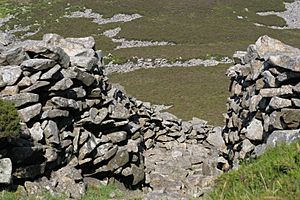- This page was last modified on 17 October 2025, at 10:18. Suggest an edit.
Tre'r Ceiri facts for kids
Tre'r Ceiri is an amazing old fort built on a hill, dating back to the Iron Age. The name Tre'r Ceiri means 'town of the giants' in Welsh. It comes from the word cewri, which is the plural of cawr, meaning 'giant'. This ancient settlement is located high up, about 450 meters (1,476 feet) above sea level. You can find it on the side of Yr Eifl, a mountain on the northern coast of the Llŷn Peninsula in Gwynedd, North-West Wales.
Historians believe the fort was first built around 200 BC. However, most of the interesting things found by archaeologists date from AD 150 to 400. This shows that people continued to live there even when the Romans were in charge of Britain.
What is Tre'r Ceiri?
Tre'r Ceiri is one of the most impressive ancient sites in all of Wales. It's a type of fort called a hillfort, which means it was built on top of a hill for protection. The settlement is surrounded by strong stone walls that are still mostly standing today. In some places, these walls are as tall as 4 meters (13 feet)!
Life Inside the Walls
Inside the huge stone walls, you can see the remains of about 150 stone houses. These houses would have had roofs made of turf, which is like thick grass and soil. During the time of the Roman Empire, it's thought that as many as 400 people might have lived here.
Some historians, like John Davies, think that because Tre'r Ceiri is so high up, the huts might have been used by shepherds during the summer. These shepherds would have taken their sheep to graze on the mountain. They probably had other homes in the lower areas for the winter months.
Exploring Tre'r Ceiri Today
Tre'r Ceiri first became well-known to many people thanks to Thomas Pennant. He wrote about it in his book called Tours of Wales. Because of its special location and historical importance, many visitors have come to see it over the years.
Recently, people have been working to protect this ancient site. They have done conservation work to keep the walls and ruins safe. They have also maintained the footpaths, making it easier for visitors to explore. A big study of the site was also done in 1956 to learn more about its history.

